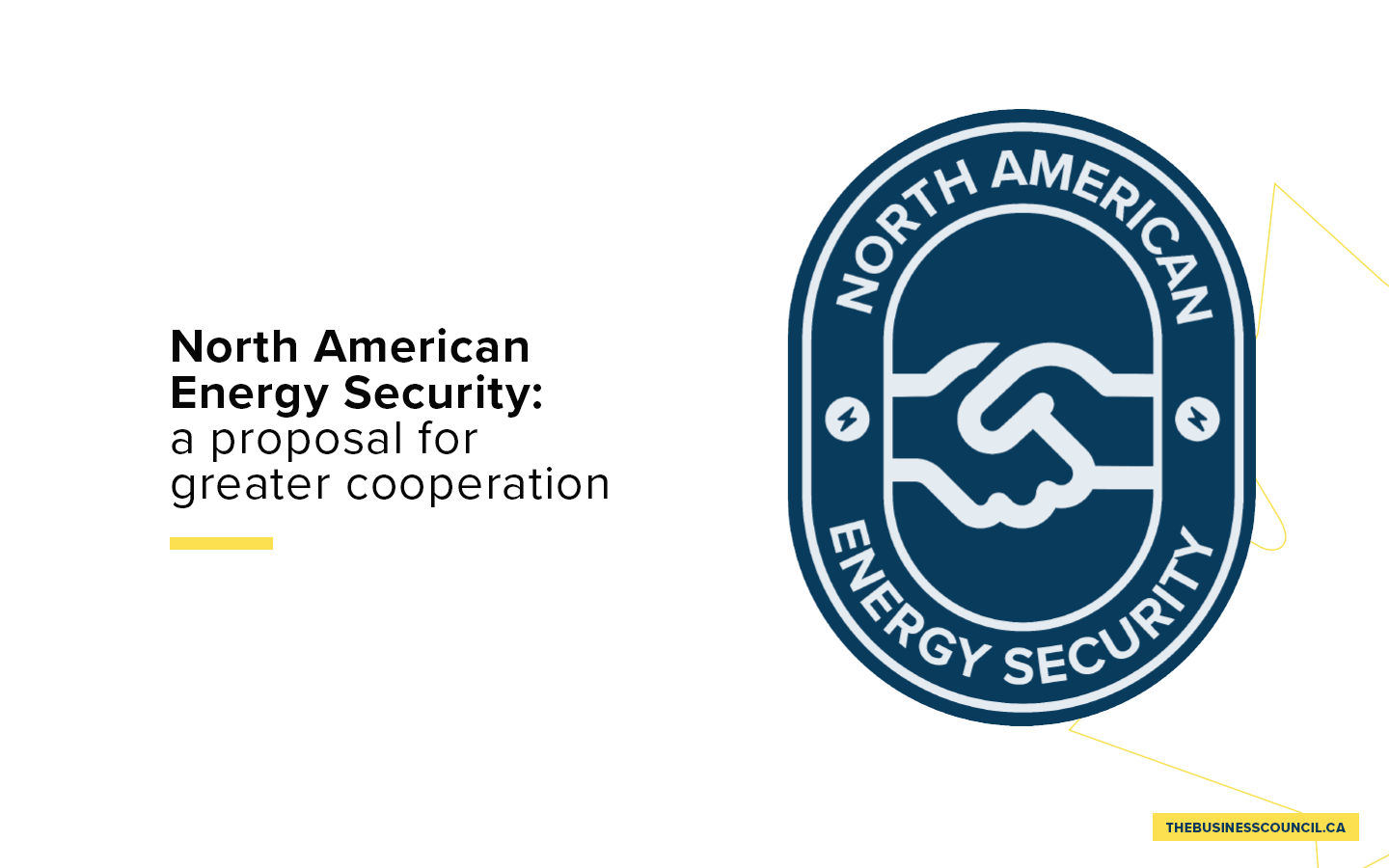North American energy security
a proposal for greater cooperation
Trade liberalization, market access and integration have been key features of North America’s energy system for decades, creating numerous benefits for the continent’s citizens and reducing energy imports from OPEC countries. Successive trade agreements have preserved these features and allowed energy production to grow and flourish, providing a stable and reliable supply of North American energy to international markets. Imposing tariffs on Canada and Mexico undermines the benefits created by decades of trade and violates the United States-Mexico-Canada Agreement (USMCA).
The United States, Canada and Mexico should not take their energy trade relationship for granted. The three countries should be building and enhancing infrastructure so that the energy ties that bind them are strengthened, not weakened. A strong regional energy partnership can bolster North American competitiveness while developing a safe and secure supply of energy for the continent’s citizens.
North America produces more oil and gas than any other region in the world. The combined power of North America’s energy sector places it as the top global producer of oil and natural gas, the top exporter of liquified natural gas (LNG) and the third-largest exporter of crude oil. Moreover, integrated energy markets and substantial cross-border trade in oil, natural gas and key minerals and materials provide the continent with a competitive advantage unrivaled by any other region of the world and reduce dependence on less reliable foreign actors.
North America is uniquely positioned to leverage its natural resources and deeply integrated energy markets to enhance energy security and the economy in the years ahead. Enhanced and formalized cross-border collaboration under the auspices of a North American energy alliance would provide an enduring framework to cement the continent’s role as a global energy powerhouse.
Oil and Natural Gas
North America’s comparative advantage has sheltered its consumers and businesses from global energy market price fluctuations increasingly influenced by escalating geopolitical tensions and the weaponization of energy. A stable supply of abundant and affordable energy paired with an integrated infrastructure and energy transport system has allowed the continent to remain competitive by ushering in an era of unprecedented investment over the last two decades, owing mostly to the U.S. shale revolution and the expansion of Canada’s oil sands.
Expansion of North American energy exports has also played a major role in helping to fill the gap left by falling Russian exports to Europe and Asia, in large part thanks to the continent’s growing LNG export capacity in the U.S. Gulf Coast. Without these facilities, North America, Europe and the rest of the world would have been far more vulnerable to the energy market turmoil that followed Russia’s invasion of Ukraine. As global demand for secure and reliable natural gas continues to increase, U.S. capacity will continue to grow and will be joined by new LNG capacity in Mexico and Canada.
| Canada | U.S. | Mexico | |
|---|---|---|---|
| Oil | – 4th largest global producer – 60% of U.S. imports | – Largest producer, consumer, and exporter in the world – Largest oil refinery throughput in the world | – 2nd largest exporter of oil to the U.S. |
| Natural gas | – 5th largest producer of natural gas – Nascent LNG export capacity | – Largest natural gas, producer, consumer, and exporter in the world | – 70% of natural gas consumed in Mexico comes from U.S. – Emerging LNG production and export hub |
| Nuclear | – 2nd largest global uranium producer and exporter – 6th largest nuclear energy producer – Top exporter of uranium to U.S.:27% of American imports | – Largest nuclear energy producer in the world – Demonstrated nuclear enrichment capacity – Receives 50% of nuclear fuel from autocratic regimes | – Some nuclear energy production |
| Critical minerals | – Over half of mineral exports go to U.S. – U.S. has a net import dependency of > 50% for 23 Canadian mineral commodities – #1 global producer of potash, major producer of nickel, cobalt, aluminum, niobium, cadmium, PGMs, titanium, indium, tellurium | – Significant producer of copper, lithium, rare earth, zinc, and molybdenum – Leading R&D on advanced recycling and processing of minerals – Growing investment in domestic refining and processing capabilities | – #1 global producer of silver Significant producer of fluorspar and strontium |
According to the Energy Policy Research Foundation, crude oil and petroleum product trade between Canada, Mexico, and the U.S now exceeds 7.3 million barrels per day, and an extensive integrated natural gas pipeline network ensures efficient and cost-effective cross-border gas flows that benefit all three countries.[1] In particular, Canada’s role as a critical supplier to the North American energy market should not be understated.
Growth in Canadian heavy oil imports is critical to U.S. refineries and is an important factor driving America’s reduced reliance on OPEC countries, with Canada now accounting for 60 per cent and roughly 100 per cent of U.S. petroleum and natural gas imports respectively.[2]
The recent start-up of the Trans Mountain pipeline expansion in Western Canada and imminent launch of LNG Canada will also grow global access to Canadian oil and gas, primarily in the Indo-Pacific region and in strategic markets along the U.S. west coast. Similarly, the U.S. is Mexico’s primary supplier of natural gas, helping the country advance its goals to reduce energy poverty and create economic growth through LNG export opportunities.
A comprehensive policy approach to expanding energy resources through a wide array of technology advancements has generated a remarkable return – upstream North American capital investments increased from approximately $50 billion (USD) in 2001 to $250 billion (USD) in 2014.[3]
These benefits go beyond generating strong returns for capital markets. They underscore what can be achieved when North American policy agendas are aligned rather than fragmented. In this case, North America has proven it can lead the world in production and exports by accessing the largest capital markets in the world and developing new energy sources and technologies. Importantly, North America’s resources and export capacity can also offer a near-term solution to global challenges concerning energy security and lower emissions energy.
Maintaining an “all of the above” policy approach will be necessary to ensure that world energy risks are minimized by the increasing strength of North American energy. Doing so will provide greater assurance that the continent’s allies and trading partners can reduce reliance on adversarial energy suppliers while also helping countries reduce emissions with natural gas supplies that reduce consumption of both coal and higher GHG-intensity gas found elsewhere.
Today, however, North American energy cooperation is fragmented due to a confusing mix of task forces and memoranda of understanding led by numerous departments and agencies in all three countries, all with varied mandates and expertise. While the USMCA includes important provisions related to energy trade, continental collaboration has languished, with the last North American Energy Ministers meeting taking place in 2017[4].
Critical minerals and nuclear fuel
While the immediate priority is to ensure that North American energy suppliers continue to provide affordable, reliable and sustainable energy, there is an emerging consensus around the need to secure various minerals and metals required for new energy and transportation technologies as well as national security. All three countries have an immense opportunity to collaborate and scale up critical mineral supply chains inclusive of extraction, processing, advanced manufacturing and recycling.
Global mining and refining capacity for critical minerals is extremely concentrated, with the bulk of raw mineral resources and processing occurring in a small number of countries. China has essentially cornered the market for a number of minerals essential to the energy transition and national security. More than two thirds of global output of mined cobalt, graphite and rare earth elements (REE) come from China, while the country’s stronghold on processing concentration is even more stark.[5] While China’s critical mineral endowment is limited, its dominance has been secured in part by its ability to secure supply from a handful of suppliers, notably the Democratic Republic of Congo, the Philippines and Myanmar.
According to the International Energy Agency, China refines all of the world’s graphite, 90 per cent of REE, three quarters of cobalt and almost two thirds of lithium[6]. China also dominates clean technology production, comprising 75 and more than 80 per cent of global battery and solar panel manufacturing, respectively[7]. This dominance poses a risk to North America’s energy posture and compromises the global effort to reduce emissions in accordance with international commitments given that China’s emissions profile far surpasses the emissions reductions currently occurring in Canada and the U.S.
Conversely, minerals mined in North America move back and forth across borders often as they undergo various stages of processing and manufacturing. Canada has top ten reserve status for important minerals such as nickel, lithium and cobalt and is a leading producer of aluminum, iron ore and copper. It remains the biggest source of imports to the U.S. for aluminum, nickel, steel, copper and niobium.
Announced in 2020, the Canada and U.S. Joint Action Plan on Critical Minerals Collaboration promotes an integrated approach to developing critical mineral supply chains and is a useful starting point for strengthening continental trade. Much work remains to overcome the challenges North America faces in terms of financing, permitting and ultimately securing a mineral supply for defence, energy transition and advanced manufacturing purposes. Canada and the U.S. are also members of the Minerals Security Partnership, a transnational association which encourages public and private sector coordination on critical minerals investments.
Canada, the U.S. and Mexico can enhance the security of the critical mineral supply chain by not only continuing to pursue these types of bilateral and multilateral agreements, but also utilizing them to identify and pursue clearcut, explicit outcomes with regards to increased mining and processing. While these formal alliances signal that North America is aligned on critical mineral priorities, it is important that they result in increased tariff-free access to minerals for and from each country and its trading partners.
Uranium
Canada is the second largest producer of uranium in the world, supplying the U.S. with nearly 25 per cent of its uranium imports[8]. Investments in Saskatchewan’s Athabasca basin, which boasts the world’s richest uranium deposits, are increasing with several projects reaching advanced stages. Comparatively U.S. uranium production is at some of its lowest levels in history while Mexico does not mine uranium.
However, major barriers need to be overcome for nuclear technology to flourish. Despite a broad acceptance for nuclear energy among political parties and the public in both Canada and the U.S., new nuclear projects have been slow to get off the ground, and barriers to mining and processing operations continue to discourage investment in technologies and fuel supplies required to further develop North America’s nuclear value chain.
Conclusion
A unified North America should be anchored in the achievement of two goals – the creation of strong and resilient energy supply chains across North America and the expansion of North America’s global reach to provide its allies and trading partners with access to a safe and secure supply of reliable and affordable clean energy.
However, achieving these goals will require a restructuring of how our respective governments work together and a new focus on building resilient energy and critical mineral supply chains across North America. All three countries have a long history of collaboration that has created a governance model built on trust. Canada and U.S. energy production and capacity to refine and process oil and gas in cooperation with Mexico can be the basis for creating stable energy supply chains in North America and improved access to global markets.
Recommendations to the governments of Canada, Mexico, and the United States:
Pursue the development of a North American energy alliance that focuses on maximizing the shared energy security, economic and geopolitical interests of the U.S., Canada, and Mexico. Core elements of the alliance could include:
- Jointly commit to an “all of the above” energy policy that directs public and private sector investment and policy support toward projects that strengthen short- and long-term energy security and resilient energy supply chains in North America. Key elements should include:
- Creating robust and resilient energy supply chain capacity in each country, reinforced by cross-border energy trade where necessary;
- Expanding LNG and other energy exports on both west and east coasts;
- Cooperating on policies related to mining and critical mineral supply chains, including identification and development of critical mineral mining and processing projects that advance national security;
- Creating a world-class nuclear supply chain to lower prices domestically and create new markets abroad; and
- Identifying shared priorities for technology development and deployment that enhances energy security.
- Creating robust and resilient energy supply chain capacity in each country, reinforced by cross-border energy trade where necessary;
- Enhance energy security intelligence capacity by creating a dedicated unit to monitor and collect information regarding risks and threats to energy and critical mineral infrastructure and supply chains in North America.
- An energy hub focused on assessing energy risks and projected demands through data sharing, mapping and informed market outlooks can support the development of resilient supply chains across the continent and expand access to global markets. The now defunct North American Cooperation on Energy Information provides a model for consideration.
- The joint energy security hub would compile a regular report on North America’s energy security outlook that provides a continent-wide view of energy forecasts, project opportunities and threats to continental supply chains.
- An energy hub focused on assessing energy risks and projected demands through data sharing, mapping and informed market outlooks can support the development of resilient supply chains across the continent and expand access to global markets. The now defunct North American Cooperation on Energy Information provides a model for consideration.
- Create a North American regulatory task force responsible for developing a common vision for identifying and expeditiously approving and permitting infrastructure and facilities that strengthen the combined resiliency of North America’s energy and critical mineral supply chains, with a specific emphasis on cross border infrastructure and integrated supply chains.
- Use North America’s advantage to advance commercial opportunities that combine energy and critical mineral exports, innovation and emission reduction policy with allies and trading partners seeking to advance their energy deficits or security risks.
Footnotes
[1] Energy Policy Research Foundation, 2025. Crude Oil and Product Movements: The North American Production Platform. Available at: https://eprinc.org/wp-content/uploads/2025/02/Chart2025-05-CrudeAndProductMovementsNorthAmericanProductionPlatform.pdf
[2] Congressional Research Services, 2025. U.S. Petroleum Trade: Crude Oil Imports from Canada and Mexico and Potential Tariffs. Available at: https://www.congress.gov/crs-product/IN12488
[3] Matthew Andrea and Rene Santos, 2021. Spotlight: Oil Project Sanctioning Is Picking Up on the back of Higher Oil Prices. S&P Global. Available at: https://www.spglobal.com/commodityinsights/pt/market-insights/latest-news/oil/062321-spotlight-oil-project-sanctioning-is-picking-up-on-the-back-of-higher-oil-prices
[4] Available at: https://www.energy.gov/ia/north-american-energy-cooperation
[5] Scotiabank Global Economics, 2023. Chronicle of Shortages Foretold: A Continental Corridor for Critical Minerals is Crucial. Available at: https://www.scotiabank.com/content/dam/scotiabank/sub-brands/scotiabank-economics/english/documents/insights-views/insightsandviews_2023-12-18.pdf
[6] Ibid.
[7] Ibid.
[8] Centre for Strategic & International Studies, 2025. Canadian Tariffs Will Undermine U.S. Minerals Security. Available at: https://www.csis.org/analysis/canadian-tariffs-will-undermine-us-minerals-security











